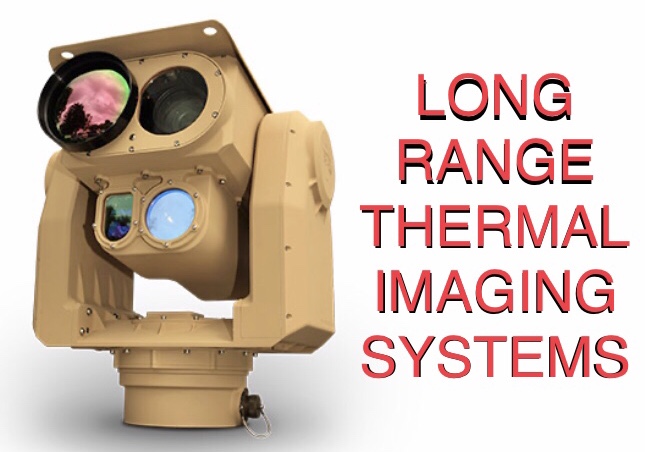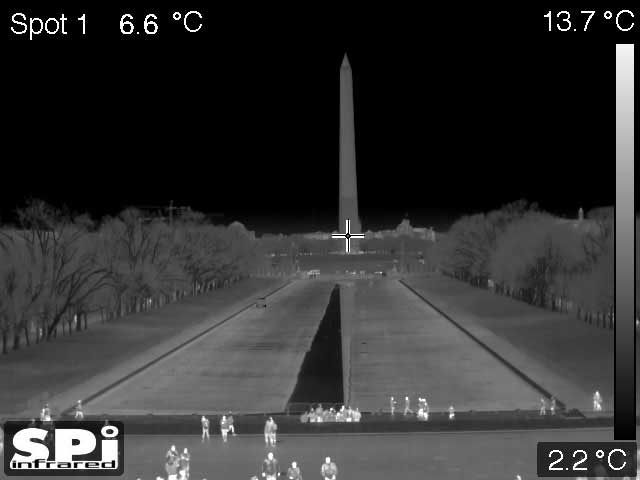
M1-D Marine Infrared Camera for Maritime Security, Search & Rescue
The M1-D Marine Infrared Camera combines visual imaging, thermal imaging and laser targeting to create a breakthrough in size, performance and features for a Marine PTZ camera system.
CALL TODAY for pricing! (702) 369-3966.

The M1-D Marine Infrared FLIR Thermal Camera is the latest multi sensor pan tilt camera system from SPI CORP. The M1-Dis the first affordable micro PTZ camera designed for use on any vessel as a marine ptz camera system. The unit features an integrated thermal camera (FLIR), CCTV visual imaging camera and laser pointer in an ultra compact rugged marine housing. The M1-D is a marine PTZ remote positioning THERMAL IMAGING COMBO CCTV CMOS system suitable for mounting on a wide range of vessels in ocean and fresh water environments. The M1-D is the breakthrough product that you have been waiting for to satisfy your imaging needs 24/7/365 at a price you will not believe.
The M1D Marine PTZ Thermal Imaging FLIR IR camera with CCTV low light camera can be custom configured to your specific application.
The M1-D marine infrared camera is loaded with features. In fact no other system on the market combines all these features into a compact, lightweight housing. In order to get a system with all these features you would have to pay many times the cost of the M1-D marine infrared camera PTZ. The M1-D is the most affordable marine thermal ptz camera on the market today. Every M1-D PTZ MARINE THERMAL FLIR IMAGER includes a high resolution thermal camera with zoom, a crystal clear visual CCTV daytime video camera and a bore sighted laser pointer for indicating objects in your field of view. The marine ptz base on the M1-D also features continuous 360 degree pan rotation and +- 90 degree tilt so you never miss the action. The system can be mounted right side up or inverted which greatly expands the mounting possibilities on today’s complicated vessels. When you find out how affordable the M1-D marine ptz thermal camera is you will not believe it.
M1-D Marine Infrared Camera Features
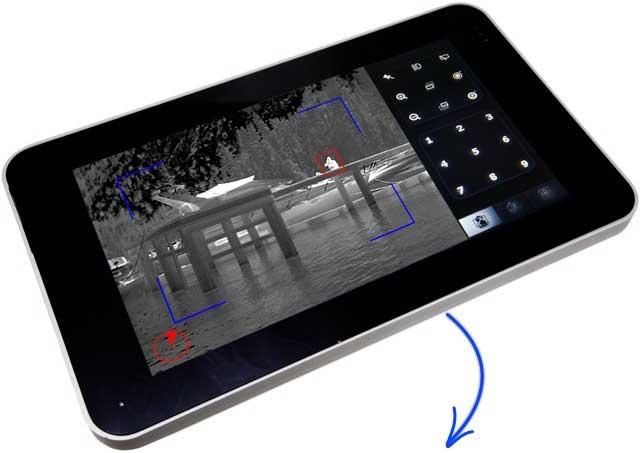
The new M1-D Tablet PTZ control interface is here. Touch screen control of your M1-D thermal PTZ system!
NAVIGATIONAL AID
The FLIR thermal sensor in the M1-D marine infrared camera gives you clear vision in total darkness. The ability to see in the dark makes the M1-D an ideal aid to navigation and compliments your existing radar to give you 360 degree visibility. Radar is a wonderful tool that is now commonplace on vessels of every size. The M1-D will not replace your radar set but rather acts in conjunction with it to give you maximum information about your surroundings. While radar will spot potential targets and terrain, the M1-D will actually give you a detailed video image of what may be lurking up ahead.
MARINE SECURITY & SAFETY
The high seas can be a harrowing place to travel. This infrared PTZ camera is so versatile it works in any conditions, making it perfect for border patrol, homeland security & detecting possible pirate ships from many kilometers away. Detect the dangers of sea travel and adjust course long before the bad guys get to you, so you make it to your destination safely with your cargo intact. This infrared camera can also protect you from colliding with unseen icebergs in the dark. Because they use thermal imaging, you’ll clearly spot the frozen danger long before you reach “Titanic” status.
MAN OVER BOARD RESCUE

M1-D FLIR PTZ Marine Infrared Camera dimensions
A FLIR Marine infrared camera sensor is so valuable to locating and rescuing stranded boaters in a man overboard situation that it should be required equipment on all vessels, large and small. The FLIR thermal sensor produces a crystal clear video image day or night regardless of lighting or weather conditions. Due to the physics of thermal imaging sensors water produces a very even “dark” background making it easy to spot objects on top of the water. A human floating in the water will stick out like a sore thumb! This can greatly reduce the time needed to spot a victim overboard, especially in the dark of night. To further aid in rescue the M1-D has a visible laser pointer so that you can pinpoint the location of the victim while circling around to retrieve them. There is no doubt about it, the M1-D Marine PTZ has the potential to save lives!
DOCKING AID
Ah the joys of docking your boat. The approach to the harbor and the process of docking a vessel in a slip or crowded anchorage can be a stressful task regardless of your skill level or boat size. The difficulty is compounded when trying these maneuvers at night or in inclement weather. Spotlights can help but by definition you can only see the “spot” that the “light” is pointed towards. With an M1-D FLIR PTZ you get a crisp full color thermal video image of the entire scene around you. Clearly see the dock, buoys, boat traffic and moorings regardless of darkness or weather. The fear of darkness and the desire to see at night are human traits deeply ingrained in our DNA. The experience of seeing in the dark literally “opens your eyes” and takes your breath away. The M1-D FLIR PTZ gives you more docking functionality than other FLIR PTZ systems on the market. With the integrated LASER designator (an M1-D exclusive) you can easily point out what you are seeing to the rest of your crew. Now instead of just barking verbal commands in the dark regarding hazards ahead you can also give them a visual cue by firing the laser. The combination of visual and auditory commands greatly increases crew comprehension which minimizes stress leading to faster and safer boat handling.
The Little Guy!
Standing a mere 6″ Tall….
With a Diameter of 4.5″….
Weighing in at 2lbs….
THIS LITTLE GUY WILL KNOCK YOU OUT!
Don’t let the micro size of the M1D PTZ FLIR Marine infrared camera fool you, this is a serious multi sensor imaging system designed for the harsh conditions of marine operations in the field. With the latest in thermal, visual and laser technologies the M1-D PTZ THERMAL CAMERA offers more to the user than systems three times the size and three times the cost. The M1-D marine Thermal imager can also be inverted making it the perfect option for mounting on mast and bridge supports.
The M1-D Marine IR camera, this little guy packs a big punch!
Test footage of the M1-D Marine camera on Lake Mohave in Arizona. It was 120 degrees so this is truly demanding conditions for a thermal camera. The M1-D is awesome.
M1-D Marine Infrared Camera Controller Options
The M1-D marine infrared camera utilizes industry standard control protocols to easily integrate with the widest variety of COTS (Commercial Off The Shelf) PTZ keyboard controllers. We have a number of joystick control keyboards that work excellent with the M1-D FLIR PTZ camera system. Most of our controllers feature integrated LCD screens for easy installation. We even have a tablet controller that operates the PTZ system and displays the video. Call us with your application and we will help you determine the most appropriate camera control option.
-

M1-D FLIR PTZ Marine Infrared Camera with lens closed
-
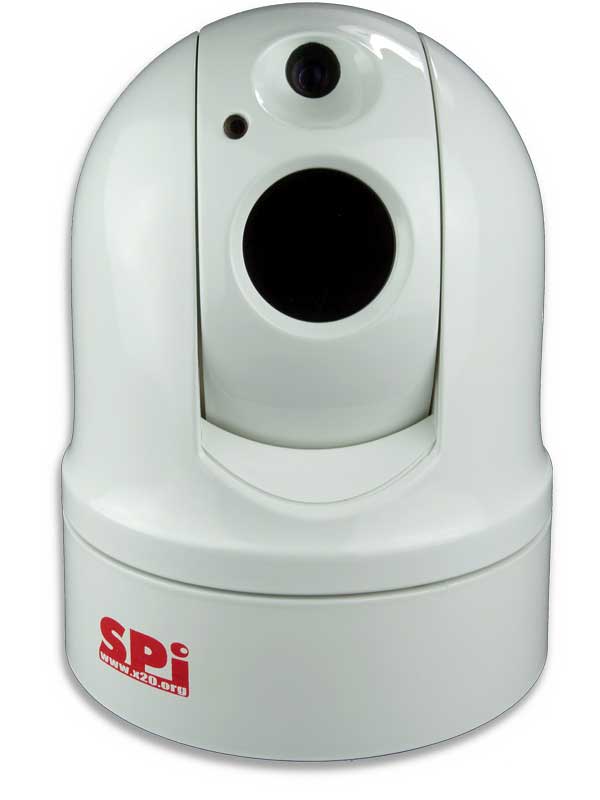
Straight on view of the M1-D marine infrared camera system
Multi purpose multi sensor EO/IR ground, marine Vehicle roof mounted thermal imaging flir PTZ camera
The M1D is the premiere Vehicle roof mounted thermal imager
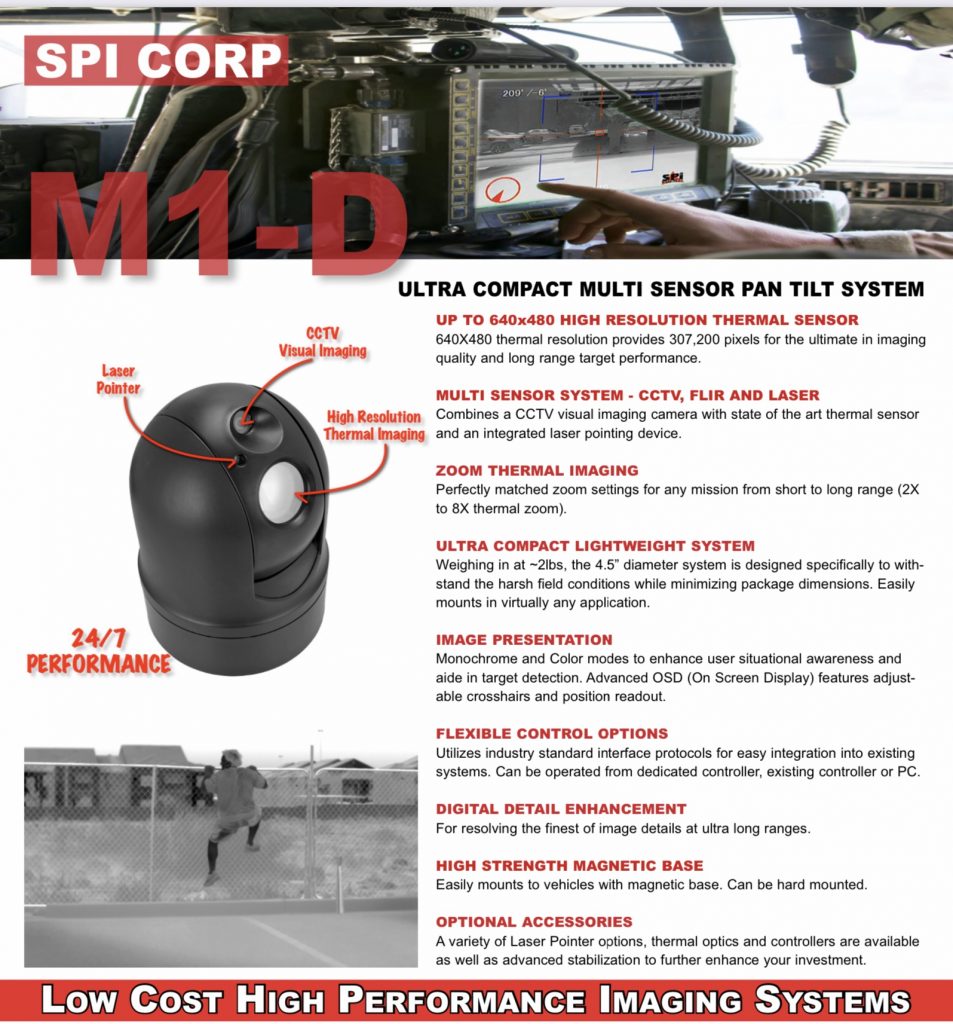
The marine M1-D is the first affordable micro PTZ camera to feature integrated thermal imaging camera (FLIR), CCTV camera and laser designator in an ultra compact rugged housing. The M1-D Roof mounted thermal camera is an all weather gimbal remote positioning system suitable for mounting on a wide range of vehicles, vessels and stationary platforms. The M1-D Roof mounted thermal camera is the breakthrough product that you have been waiting for to satisfy your imaging needs 24/7/365. This is a very efficient unit with Nominal 1.5-2.0 amps @12VDC Max 2.5 amps consumption. The M1D Roof mounted thermal camera is a great choice as a vehicle mounted FLIR camera for situational awareness, drivers vision enhancer DVE and search & rescue SAR applications.
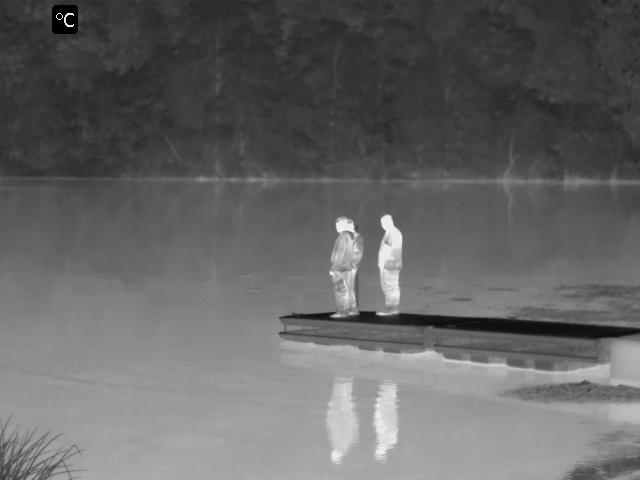
Included and integrated within the M1D marine gimbal turret is a sensitive Daytime Color / Low light camera which offers 1028×768 resolution with TELEPHOTO ZOOM for extended range and very good Day/Night imaging capabilities that compliments the included FLIR thermal imager camera sensor & Laser sensor.
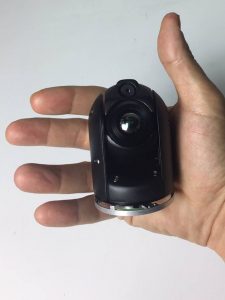
Included and integrated within the M1D marine Roof mounted thermal camera is a sensitive Daytime Color / Low light camera which offers 1028×768 resolution with TELEPHOTO ZOOM for extended range and very good Day/Night imaging capabilities that compliments the included FLIR thermal imager camera sensor & Laser sensor.
The M1-D marine All Weather Roof mounted thermal camera is ideal for UAV drones, cars, boats and building applications, the system is a rugged affordable solution for:

THE COMPLETE M1-D MICRO FLIR PTZ UAV THERMAL CAMERA SYSTEM
- UAV copter airborne aerial imaging
- PT Pan Tilt imaging system for car, vehicles, mobile roof mount applications.
- Marine, boat, seaborne and coastal imaging
- Ground based security, fixed, building remote surveillance imaging
- Fixed installation imaging
- Mobile, car, vehicle, rooftop mounted vehicle gimbal ball imaging system
- Remote tactical thermal imaging and CCTV laser camera
- Mast mounted, tripod mounted imaging solution
- Custom Integration solution
-The M1D marine Roof mounted thermal camera is available in the ENHANCED 336 THERMAL IMAGER CAMERA with 13mm Germanium Optics and 8x Ezoom
-The PREMIUM 640 Thermal Camera Version offers 19mm Germanium Optics and 8x Ezoom
-White Hot imaging palette is preset to all units.
-The ultimate roof mounted thermal camera
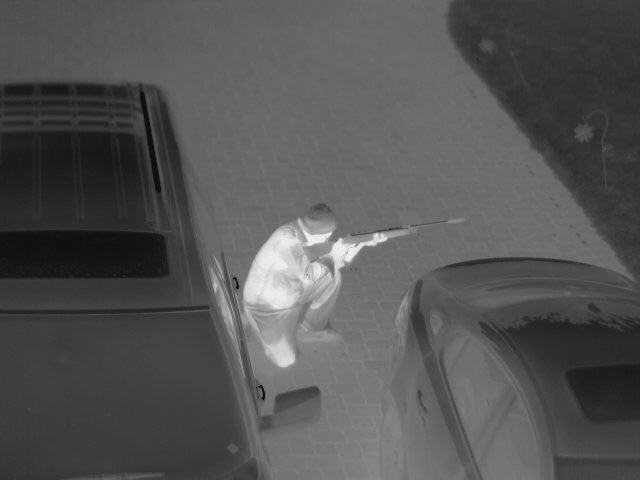
OVERVIEW
ULTRA COMPACT MARINE MULTI SENSOR PAN TILT SYSTEM
UP TO 640×480 HIGH RESOLUTION THERMAL SENSOR
640X480 thermal resolution provides 307,200 pixels for the ultimate in imaging quality and long range target performance.
MULTI SENSOR SYSTEM – CCTV, FLIR AND LASER
Combines a CCTV visual imaging camera with state of the art thermal sensor and an integrated laser pointing device.
ZOOM THERMAL IMAGING
Perfectly matched zoom settings for any mission from short to long range (2X to 8X thermal zoom).
ULTRA COMPACT LIGHTWEIGHT SYSTEM
Weighing in at ~2lbs, the 4.5” diameter system is designed specifically to with- stand the harsh field conditions while minimizing package dimensions. Easily mounts in virtually any application.
IMAGE PRESENTATION
Monochrome and Color modes to enhance user situational awareness and aide in target detection. Advanced OSD (On Screen Display) features adjust- able crosshairs and position readout.
FLEXIBLE CONTROL OPTIONS
Utilizes industry standard interface protocols for easy integration into existing systems. Can be operated from dedicated controller, existing controller or PC.
DIGITAL DETAIL ENHANCEMENT
For resolving the finest of image details at ultra long ranges.
HIGH STRENGTH MAGNETIC BASE
Easily mounts to vehicles with magnetic base. Can be hard mounted.
OPTIONAL ACCESSORIES
A variety of Laser Pointer options, thermal optics and controllers are available as well as advanced stabilization to further enhance your investment.
Low Cost imaging systems systems.
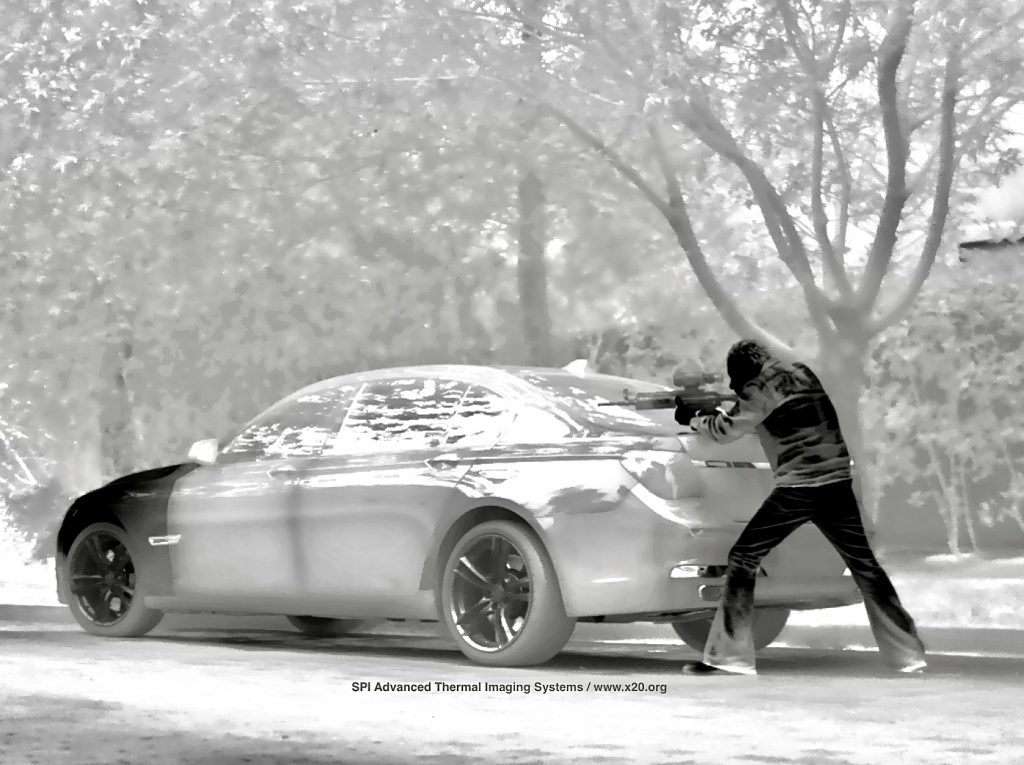
The M1-D marine Roof mounted thermal camera is the next generation in multi sensor pan tilt imaging systems. The M1-D combines ultra high resolution 640×480 thermal sensor with a crisp CCTV imag- ing camera and long range laser pointer. The M1-D is a fully weatherized system that is compatible with most existing vehi-
cle, vessel or facility infrastructure. The M1-D’s marine ultra compact form factor and easy installation lets you mount the system vir- tually anywhere. The M1-D is the ultimate in 360 degree situational awareness.
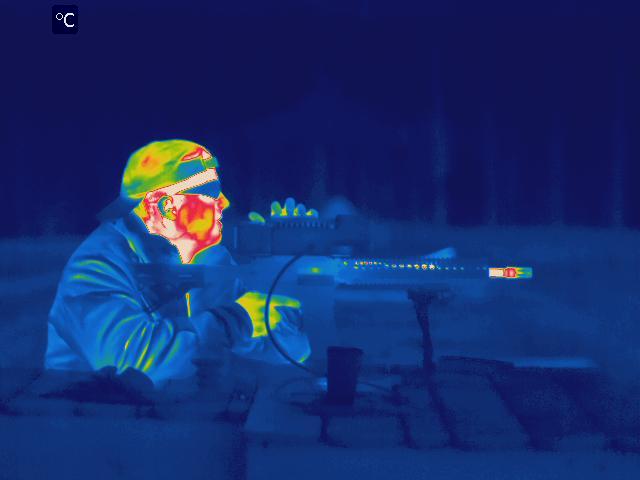
The marine Multi-Sensor Ultra Compact Imaging System is designed from the ground up to balance rugged all weather performance and operator comfort. The ultra lightweight compact design allows you to deploy the system across the widest array of platforms. Multiple sensors greatly enhance operator awareness for 24/7 360 degree situational awareness. Laser indicating further enhances opera- tional capabilities by bringing in your whole team.

Our experience has also uncovered a nasty truth about most marine grade thermal PTZ systems on the market. The truth is that they all have blind spots. WHAT? How could that be? The problem is that most of these systems cannot look straight up. This means if you are tracking airborne threats or up a hillside you will run out of motion and loose the target. Now tell me, don’t you want to look straight up? Call us and we can also talk inverted operation sir.

24/7/365 the M1-D, drone, car, Vehicle, boat, mobile, marine thermal camera is always there for you no matter what your mission profile is.
This is the worlds first affordable marine flir Micro Pan Tilt Zoom system that incorporates high resolution thermal imaging sensors, CCTV visual imaging with instant zoom and a laser designator for always on target precision and persistent performance. Thermal imagers see heat energy and not light so they work in any lighting condition from broad daylight to complete darkness. Thermal imaging is the undisputed king of night vision technologies. The CCTV camera gives you sharp visual light images in most all lighting conditions to aid in identification. The unique laser pointer module lets you designate threats to your team to keep you safe and let you get your job done. Weighing less than 3 lbs and measuring about 4.5″ in diameter, the M1-D UAV thermal camera gimbal turret is truly a micro sized powerhouse. Ideal for UAV / UGV, SUAS, drone, quadcopter and multicopter night vision, IED detection / UAV EOIR gimbal turret, tactical ISR, persistent surveillance and a wide array of custom applications.

The expanding field of Unmanned ground vehicle and unmanned Aerial Vehicle opens the doors to the innovative M1D, The unit
is an affordable turn key, high grade EOIR gimbal turret solution for land, sea and air optical imaging. With the M1D the “skies have eyes” in the field of UAV cameras for commercial, industrial, law enforcement and military persistent surveillance.
Black and white thermal imaging is the industry standard for surveillance imaging systems. The grayscale imaging palette provided with all systems produces crisp accurate imaging profiles of the scene you are viewing. A black and white TV also produces crisp images but you wouldn’t buy a black and white TV would you? Of Course Not (they don’t even make them anymore!). The M1-D is a modern thermal imaging system that offers you B/W and COLOR performance all at a low price.
“If your needs are for a multi sensor mini gimbal PTZ ruggedized, robust & all weather Thermal FLIR camera then the M1-D marine is your quick and affordable solution.”
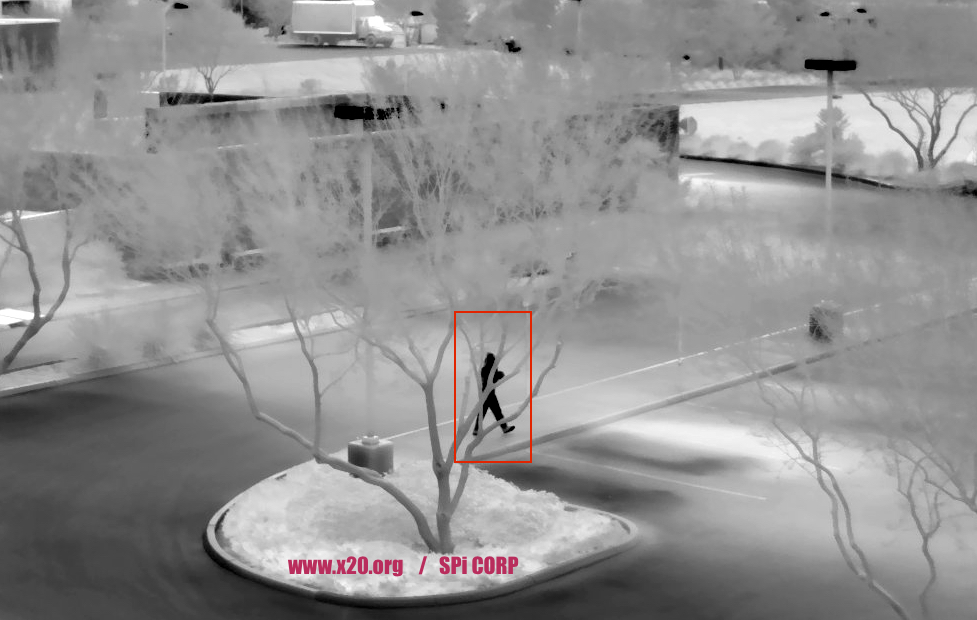
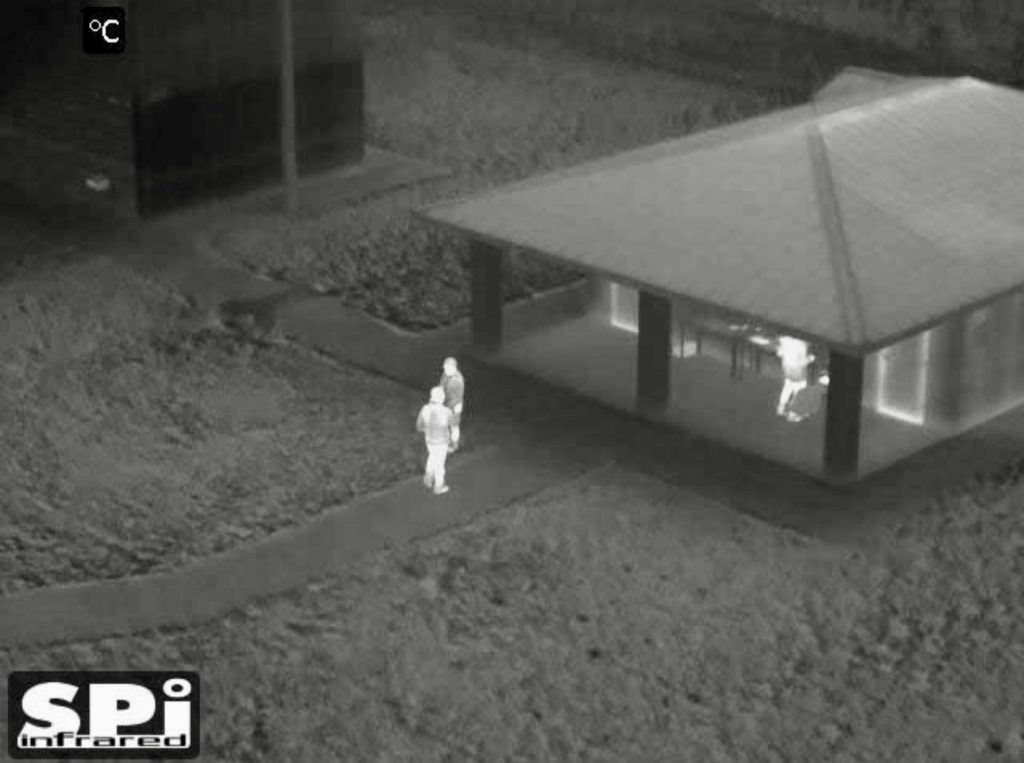
The M1D marine roof mounted thermal imaging flir PTZ camera is easily mountable to any drone, UAS, UAV or multicopter platform for enhanced imaging. The unit has been outfitted onto many unmanned systems for commercial, industrial and military applications. The small gimbal turret is very stable and has many mounting options. A huge advantage to the M1D gimbal is its affordability allowing the users to use an effective airborne imaging system with multi sensors and cameras. The thermal FLIR imaging camera channel now has optional radiometric capabilities allowing it to display real time temperature measurement of the scene and being able to measure temperature values in Fahrenheit or Celsius up to 1000C with accuracy of +/- 2%. The hand selected thermal FLIR detectors have sensitivity of 1/10 of a degree therefore any subtle temperature changes in the image as small as a tenth of a degree will be shown and measured real time. The M1D Vehicle roof mounted thermal imaging flir PTZ camera can be used as the primary imaging gimbal turret payload or as a secondary backup situational awareness camera.
The low price M1D marine roof mounted thermal imaging flir PTZ camera has double layered rugged protection ensuring a rugged housing which works flawlessly in all weather scenarios. The on screen symbology on the users has useful data which can be turned off to just display the imagery directly from the sensors.

SPI Offers The M1/STAB marine Image stabilization module which can be outfitted at the point of viewing and not at the M1D PTZ site, this compact device allows for effective image stabilization with user input preferences for stabilization equalization and roll/pitch amounts desired for a steady imagery, without spending thousands of dollars on multi axis stabilization.

Standing a mere 6″ Tall….
With a Diameter of 4.5″….
Weighing in at less than 3lbs….
Don’t let the micro size of the M1-D marine thermal camera fool you this is a serious multi sensor imaging system designed for the harsh conditions of marine operations in the field. With the latest in thermal, visual and laser technologies the M1-D offers more to the user than systems three times the size and three times the cost. The M1-D can also be inverted making it the perfect option for mounting on mast and bridge supports.

THE M1-D FLIR CAMERA IS SMALL BUT MIGHTY!
The M1-D, this little guy packs a big punch!
Really this is serious. Maybe you are not grasping just how small the M1-D thermal pan tilt camera really is. You are probably thinking “Ok it has a thermal camera in it plus its got a visible CCTV camera and oh yeah they said it has a laser pointer too so it can’t be that small”?
Really it is. Okay how can we really demonstrate the true size of this device so that you can picture it in your head? The picture on the right with the measurements is a good start but its not intuitive enough……..hmmm. Oh that’s a good idea. Sure lets take a picture of the unit in someones hand. So small its the worlds first handheld pan tilt multisensor thermal camera!!
Never before has so much power and capability been able to fit in the palm of your hand. Get an M1-D and SEE what is out there.
Flexible Mounting Options

SPI has been designing, building and supplying marine grade thermal PTZ systems for a decade. Based on user feedback we know that you want options. The M1-D UAV thermal camera has multiple mounting options based on your needs for real world solutions. Magnetic mounts are super strong to hold to vehicles in virtually any conditions. Strong magnets are nice but it is the little details that set the M1 apart. Each super strong magnet is covered in a durable clear plastic coating that prevents the unit from scratching the roof of your vehicle. A nice touch from folks that really think about how you are going to use the system. In addition we have hard mount points for those applications that demand the strongest attachment possible. Whatever your needs the M1-D has got you covered. The M1D is the smallest and most affordable PTZ LWIR long wave infrared multi sensor Eoir camera system.

Airborne / UAV Gimbal
The M1-D thermal pan tilt zoom system is mounted on a twin prop aircraft for flight testing. Many companies are selecting the M1-D as the future of low cost thermal aerial payloads.
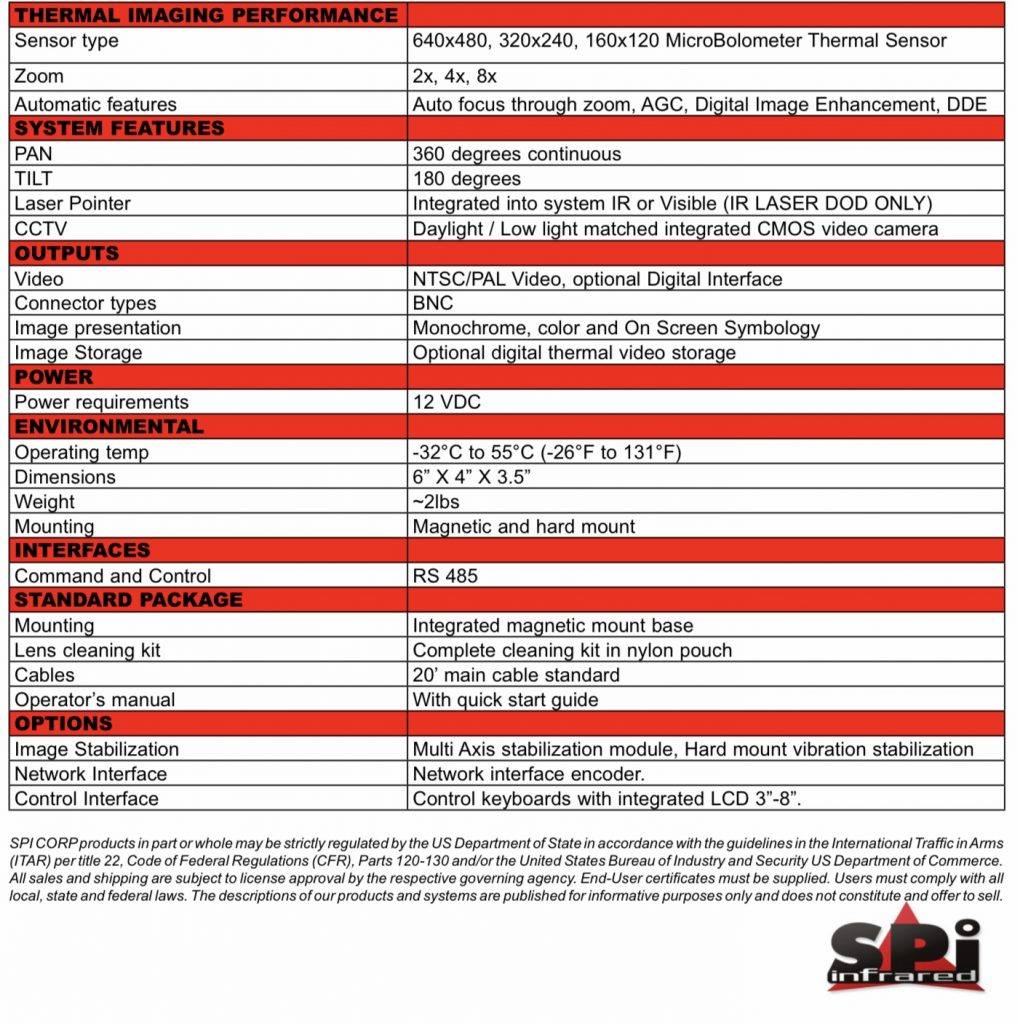
CLICK HERE FOR OUR LONG RANGE THERMAL
IMAGING FLIR CAMERA SYSTEMS
Overview
The Far Infrared sensor aka flir or LWIR for marine roof mounted thermal imaging flir camera market has seen incredible growth over the past five years, with industry analysts suggesting fourfold growth for the number of units in 2017 alone. Indication from the market is that the use of roof and vehicle mounted thermal imaging flir cameras in automotive, especially for safety and night vision for autonomous vehicles, is taking off and could be the key to mass-market adoption of fully autonomous vehicles. Source: Uncooled Infrared Imagers Market and Technology.
Sensors have been part of ADAS systems for some time. Primarily, these have included radar, camera, and lidar sensors, all of which have their limitations in terms of detection of pedestrians, vehicles, and objects on the road, thus rendering them unsuitable as singular options to support autonomous driving. Autonomous vehicles are still not meeting key safety guidelines, because the sensor suites are not up to the task to deliver complete coverage and detection in all scenarios, weather, road and lighting conditions. For this reason, a human driver must be ready at every moment to take control of the vehicle.
Unlike other sensing modalities, thermal sensors don’t require any light to accurately detect, segment, and classify objects and pedestrians and are, therefore, well-suited to drastically improve AV systems’ safety at night.
In addition to night driving, a key concern for OEMs is developing autonomous vehicles that can maintain adequate coverage in any lighting condition and in any kind of harsh weather. Flir can satisfy both of these use cases and has, thus, become recognized in the automotive market as a crucial sensor for Level-3 autonomous vehicles. As OEMs look ahead to the future advancement of vehicle autonomy, they also see Flir as an essential enabler for Level-4 and higher vehicle autonomy and are beginning to seriously evaluate the sensing technology in their prototypes. For example, two leading OEMs have already announced that they are using thermal-imaging cameras as part of their sensor suites for their self-driving prototypes. Other will surely follow.
To eventually achieve Level-3 and up autonomy and bring fully autonomous vehicles to the mass market, many AV developers have reached the consensus that each vehicle must be equipped with multiple sensors. Specifically, in order to enable complete detection and the most comprehensive understanding of vehicles’ surroundings, automakers are favoring the use of multiple roof and vehicle mounted thermal imaging flir cameras sensors, as this technology can deliver the highest level of safety.
However, even with a human driver present, autonomous pilot projects are still experiencing setbacks. Following several self-driving car-crash occurrences in the past year, many big OEMs have slowed down the implementation of their pilot projects and are, instead, favoring a slower approach to deployment that increases the focus on safety.
To ensure such safety across autonomous vehicle systems, the U.S. Department for Transportation’s Federal Automated Vehicles Policy now requires redundancy for critical AV systems. To satisfy these requirements, most OEMs and tier-ones are using multiple sensors and other components as fail-safe measures; specifically, they have identified roof and vehicle mounted thermal imaging flir cameras technology as a key sensor that can help their vehicles meet the ever-rising standards for safety.
The U.S. Department of Transportation’s Federal Automated Vehicles policy redundancy regulations are outlined in the recent document, Preparing for the Future of Transportation: Automated Vehicles.
There are various driving conditions in which roof and vehicle mounted thermal imaging flir cameras sensing would increase the safety of AV systems. For example, as one of the many scenarios that plagues other sensing solutions, night-driving often poses the same challenges for autonomous vehicles as it does for human drivers. The darkness makes it difficult to see people, objects, animals, and other vehicles, because there is not enough contrast to clearly view the scene. As a result, the vehicle’s sight is restricted to areas only in which the headlights shine. This proves dire for autonomous vehicles’ navigation of the road, particularly when in the vicinity of pedestrians: The Insurance Institute for Highway Safety says that pedestrian deaths are rising fastest during night driving, and federal census data shows the same–three quarters of pedestrian fatalities happen at night.
The automotive market sees marine Flir thermal infrared IR imaging PTZ cameras as the enabling sensor technology for full autonomy, because, in addition to its impressive sensing capabilities, the technology, now experiencing a next-generation revolution for the automotive industry, is also uniquely affordable for mass market deployment.
Its superior detection in dynamic lighting, harsh weather, and night scenes, in addition to its affordability for the mass market and its redundancy for safety are just some of the factors that are motivating OEMs to seek out Flir solutions to enable Level-3 and up driving. The market now believes that thermal sensors must be a part of autonomous vehicles’ sensor suites in order to deliver the highest levels of safety and the most accurate sight and perception of surroundings.
The remaining question is: What key features of marine FLIR thermal imaging sensing need to be considered when integrating the solution into a vehicle? First, OEMS need to understand the best use cases for thermal imaging flir sensors; then, they must identify what key features they should look for when choosing-roof and vehicle mounted thermal imaging flir cameras perception solutions for their applications. The technical advantages of roof and vehicle mounted thermal imaging flir cameras and when and where flir and a CMOS camera can be fused for a complete sensing solution.
LIVING AND NON-LIVING OBJECT DETECTION
By accessing a different band of the electromagnetic spectrum and sensing objects’ thermal energy, roof and marine mounted thermal imaging flir cameras sensors are able to seamlessly identify any living object in a vehicle’s surroundings. The technology also proves itself as the best modality for non-living object detection: In addition to reading an object’s thermal signature, roof and vehicle mounted thermal imaging flir cameras cameras also capture objects’ emissivity—the rate at which an object emits heat. Emissivity is affected by each object’s surface material, so every object with a different surface nature (e.g. the cracks on the road versus the sidewalk) would bear a different thermal signature. Thus, since every material has a different emissivity (and a different reflectance (i.e. the proportion of radiation striking a surface that is reflected off of it)), a-roof and vehicle mounted thermal imaging flir cameras can immediately detect and classify any object—living or non-living—in its path…
INVARIANT IMAGES FOR LIGHTING CONDITIONS
roof and marine mounted thermal imaging flir cameras further trumps other sensing modalities, as it delivers an invariant image for lighting conditions: Its image perception is not compromised by the color of an object, an object’s’ background, the direction of illumination, a multiplicity of light sources, specular reflections, nor many other image irregularities that may stem from variable lighting conditions in regular CCD CMOS EOIR images. For instance, although CCD CMOS Eo/Ir cameras are usually quite good at detecting lanes and other road markings, they may struggle to accurately detect the drivable road area–even in daylight–due to the high variance in the visual road appearance in CCD CMOS Eo/Ir images. The visual road appearance in a-roof and vehicle mounted thermal imaging flir cameras image is much less variable; it retains similar characteristics in many different lighting conditions.
Delivering an invariant image for lighting conditions is critical for autonomous vehicles to be able to see their surroundings in the highest quality necessary to understand and react to both living and non-living objects.
Besides enabling vehicles to see and understand their surroundings in any lighting condition, the invariant images produced by-roof and vehicle mounted thermal imaging flir cameras also help support machine perception. In fact, any feature that relies on machine perception for further planning and control will benefit from the invariant images roof and vehicle mounted thermal imaging flir cameras delivers. Such perception-based tasks include: on-road object detection, classification, intention recognition, tracking, distance estimation, and semantic segmentation. Due to the high-quality images roof and vehicle mounted thermal imaging flir cameras produces, these tasks may be improved with a roof and vehicle mounted thermal imaging flir cameras fusion sensing solution.
Localization and mapping can also benefit from roof and vehicle mounted thermal imaging flir cameras imagery. The amount of detail and information that this modality can offer is rich enough to enable tasks like SLAM (Simultaneous Localization and Mapping). Moreover, landmark-based approaches for SLAM may also be easily applied on roof and vehicle mounted thermal imaging flir cameras data due to the high resolution that these next-generation sensors produce.
Together, all of these technical advantages enable roof and vehicle mounted thermal imaging flir cameras sensors to see things that other sensors miss, giving autonomous vehicles better scene detection and analysis, both of which are key requirements for achieving Level-3 or higher autonomy.
TECHNICAL ADVANTAGES of roof and vehicle mounted thermal imaging flir cameras
roof and marine mounted thermal imaging flir cameras technology, however, gives vehicles the complete, reliable detection of the road and its surroundings. It’s able to do this when other sensing solutions can’t, because of its distinct technical advantages:
• All-weather detection
• Living and non-living object detection
• Invariant images for lighting conditions
ALL-WEATHER DETECTION
roof and marine mounted thermal imaging flir camera sensors are capable of delivering reliable, accurate detection in real-time and in any environmental condition, because they access an additional layer of information that the other sensors don’t.
Unlike radar and lidar sensors that both transmit and receive signals, a-roof and vehicle mounted thermal imaging flir cameras passively collects signals by detecting the thermal energy that radiates from objects. By sensing this infrared spectrum that’s far above visible light, roof and vehicle mounted thermal imaging flir cameras access a different band of the electromagnetic spectrum than other sensing technologies do. Most of the electromagnetic spectrum is blocked by the atmosphere, with only narrow spectral windows that can let the EM radiation through. The visible light window roughly spans 400-700 nm wavelengths; whereas, the infrared window that is commonly used in low-cost uncooled thermal imagers spans 8-14 μm wavelengths (also known as LWIR (long-wave infrared)). Thus, the roof and vehicle mounted thermal imaging flir cameras is able to generate a new layer of information, making it an all-weather solution that enables AVs to detect objects that may not otherwise be perceptible to radar, cameras, or lidar.
It’s also worth noting that roof and marine mounted thermal imaging flir cameras passivity offers another advantage to autonomous vehicles: no interference. Because lidar and radar are active, energy-emitting modalities, the lidar and/or radar installed and functioning on one vehicle may interfere with and upset that of another passing vehicle. Conversely, as a passive technology, roof and vehicle mounted thermal imaging flir cameras can work to detect and cover a vehicle’s surroundings without ever upsetting the sensors of other vehicles.
roof and marine mounted thermal imaging flir cameras Fused with additional camera sensors
Although roof and vehicle mounted thermal imaging flir cameras superior image perception enables it to successfully provide coverage in a variety of adverse weather and lighting conditions and in the midst of pedestrians and animals (as compared to HD CCD CMOS EOIR sensors), the technology’s proponents do not suggest that roof and vehicle mounted thermal imaging flir cameras replace all other sensors as the sole means of perception. Rather, they affirm that roof and vehicle mounted thermal imaging flir cameras be fused with a HD CMOS Eo/Ir solution to deliver more comprehensive sensing capabilities needed to achieve full autonomy. Researchers from The AWARE (All Weather All Roads Enhanced vision), a French public funded project, have even confirmed long-wave infrared is the best wavelength band to complement CMOS EOIR for road applications.

